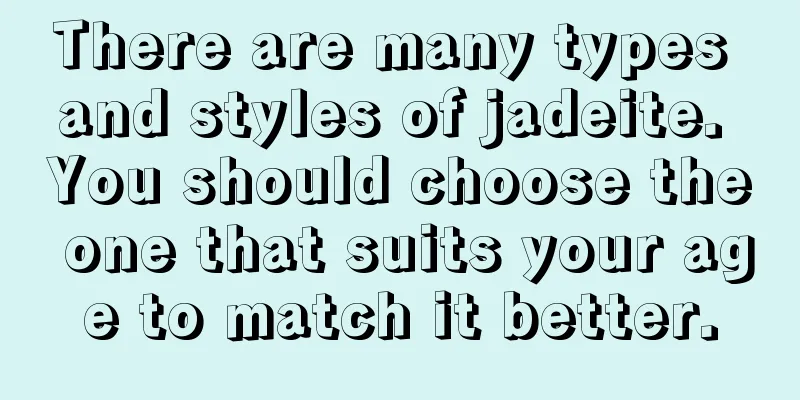Basic knowledge of jadeite collection: How much do you know about jadeite terminology?

|
When talking about jadeite, everyone’s impression is that it is expensive and loved by many collectors. The media often reports that this or that jadeite is sold at sky-high prices. For this reason, many people collect some jade jewelry to a certain extent. In order to buy the jade they like and the real thing, most people will learn the basic knowledge of jade collection through some channels, but their knowledge of jade may still be at their own personal understanding level, and they don’t even understand the terminology related to jade. Therefore, the editor has specially compiled and listed the relevant terms of jade knowledge this time. Friends who love jade can take a look. 1. What do A-grade, B-grade and C-grade jadeite mean in jade terminology? Grade A jade: refers specifically to natural jade, which is made by carving and polishing the raw jade ore after it is mined, without any other processing. The color of the jade is natural, and people in the industry call it "true color" or "real color". Observed with the naked eye, its texture is delicate and soft, with obvious stone patterns. B-grade jadeite refers to jadeite that has undergone artificial chemical treatment. Jadeite of poor quality is not valuable. Merchants will remove impurities and stains from the jadeite by rinsing it with strong acid, and then use other substances to fill the space lost by acid erosion. Jadeite treated in this way is called B-grade jadeite, and will be marked as "B-grade" or "jadeite (treated)" on the formal appraisal report; C-grade jadeite refers to jadeite and its products that have been artificially processed by adding foreign dyes or drugs. The method is to add relevant dyes to the originally colorless jade under high temperature and high pressure environment, so that the originally colorless body is completely or partially transformed into colored jade, such as emerald green or purple. Dyed jade will become lighter or dull and lifeless over time. 2. How to interpret the price in jade terminology We often hear many people in the industry use terms like "Xiao Wu" or "Zhong Liu" when talking about the price of a piece of jade, which makes people confused. So what exactly do these terms "Xiao Wu" and "Zhong Liu" mean? In fact, these refer to a price range of jadeite, not specific prices. Small, medium and large represent the first digit of the price, 1-3 is small, 4-6 is medium, 7-9 is large, and three, four and five are the digits that indicate the price. After understanding these terms, we know that the small three means 100-399, the middle four means 4000-6999, and the big five means 70000-99999. If the value of a piece of jade is around 3,000 yuan, we can say that the price of this jade is mistress. 3. What do the words "fei", "cui" and "chun" in jade terminology mean? Jade: Jade is a description of color, referring to red and yellow. Since it is called jadeite, jadeite containing jade must be very precious and valuable; Cui: Cui is also a color, referring to green. Green is the most precious color among all jadeite, so jadeite containing emerald is the most valuable and the most authentic; Spring: Spring is also called violet, because the color of jade is purple, similar to the violet flower. Violet is beautiful and warm in color, and is also very popular among jade lovers. Jadeite, emerald green and spring are the three most important colors of jadeite. Of course, there are other colors such as white and black, but the value of jadeite is not high. 4. What are the other basic terms for describing jadeite? 1. Water head: The color of jadeite and the quality of its transparency. The degree of transparency is generally described by long, short, good or bad. 2. How much water: When light shines on the surface of jade, we can divide it into one point of water, two points of water, and three points of water according to the depth of light entering the jade. The amount of water also refers to the transparency of jade, and the two are directly proportional. 3. Bubbles: refers to the white granular or block-shaped impurities contained in jade. 4. Black flowers: refers to the black defects distributed in the form of dots, filaments or bands inside the jade. 5. Tobacco: Brown defects like tobacco inside the jade. 6. Rigidity: It means that the fine texture of jadeite has strong reflective properties like stainless steel surface after processing and polishing. 7. Tobacco: Brown defects like tobacco inside the jade. 8. Thin Water: refers to jadeite with poor transparency, which can also be translucent after being processed into thin slices. 9. Live black: refers to black defects that can be observed with the naked eye. They appear dark green when illuminated by a flashlight. Black defects can spread to the surrounding areas after a long time. 10. Dead black: The opposite of live black, this black defect is clustered but non-diffusive. 11. Material: refers to artificially synthesized glass imitations. 12. Dry: refers to jade with poor transparency, generally jade with coarse grains. It is the antonym of full of moisture. 13. Group color: It means that the colors of jade raw materials are different and distributed in clusters.
fcgc33 fcpf18 |
>>: How is the collection value of jadeite reflected? Things to note when collecting jadeite
Recommend
Jade World - Four major schools of carving
In the martial arts world, every sect that has gr...
Scientific jade identification, it is particularly important to understand these points
Jade was discovered by the Chinese. For hundreds ...
Appreciation | The Five Beauties of Jade
Jade is a product that takes billions of years to...
Jadeite rough stone: Unbelievable high quality jadeite actually comes from rough stone, the stone should not be judged by appearance
Jade is a common type of jewelry on the market. I...
Tracing Jade Culture
Jade has a very special identity. As a high-end j...
The unique beauty of the emeralds with various patterns cannot be hidden
It is said that there is no order without rules, ...
Play with jade, invest, and collect! Even experts may not know how to choose collection-level jadeite!
We usually divide jade into two levels, wear-grad...
Why does jade need to be inlaid?
Jade inlays are mainly used in jewelry. In our da...
Why is Jadeite valuable for investment?
95% of the gem-grade jade produced in the world c...
Jade rings are cheaper than bracelets and more fashionable than pendants. You deserve better in the new year.
Jade has been deeply loved by the Chinese people ...
Jadeite cut from the Damakan raw stone is also beautifully carved like this
What I want to share with you today is a jadeite ...
Jade carving art and color matching techniques
An exquisite and noble jade product not only requ...
How many folk remedies for identifying jadeite do you know?
The jade market is now a mixed bag. Many unscrupu...
Chinese Jade Culture
The color of jade is beautiful and its essence is...
The jadeite sheet I stole from a friend, after some carving and processing, I couldn’t put the finished product down!
This small piece of material was found by the edi...









